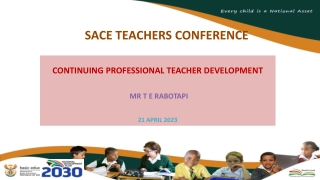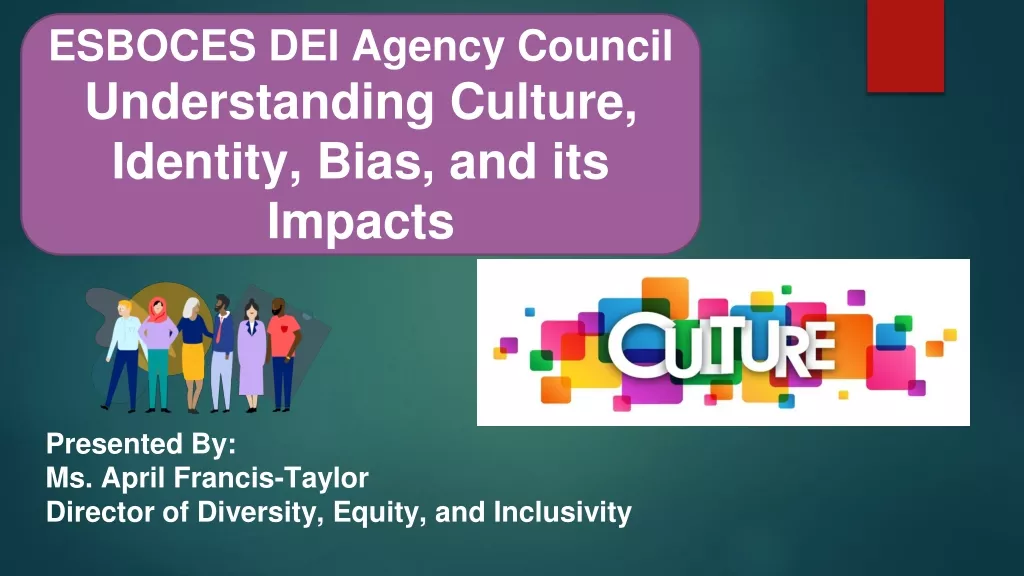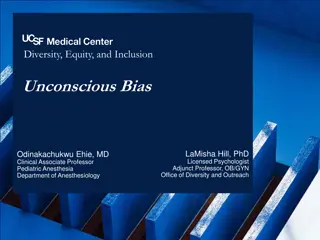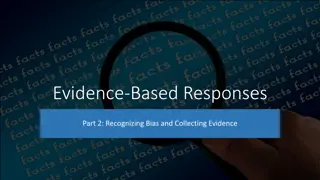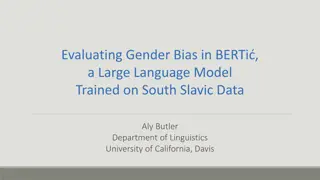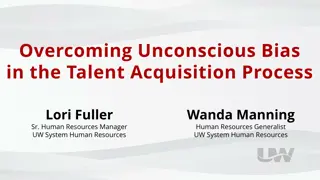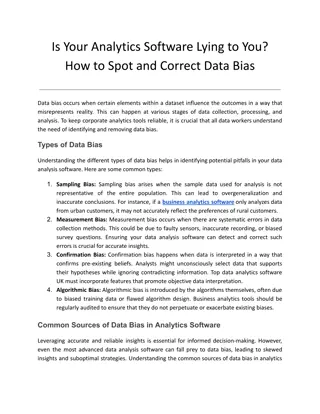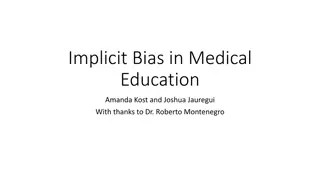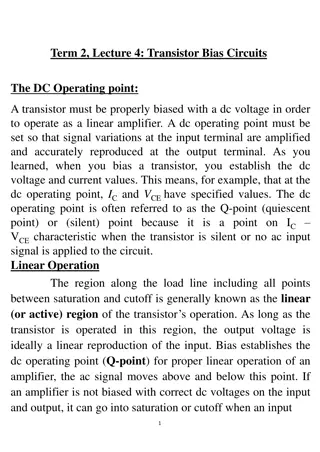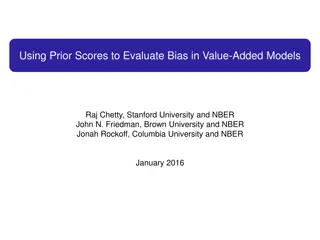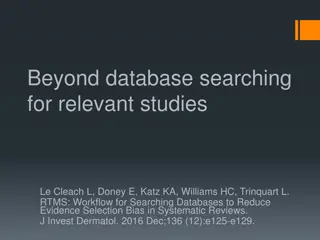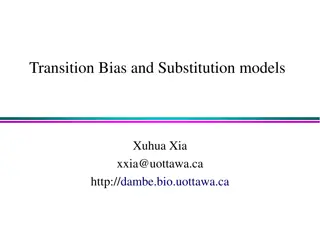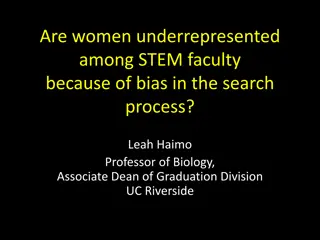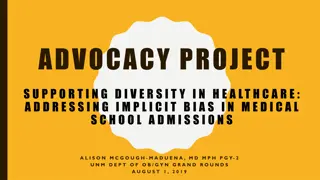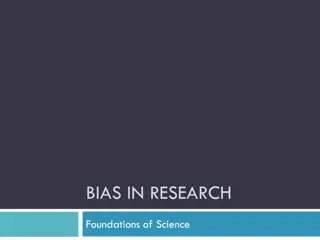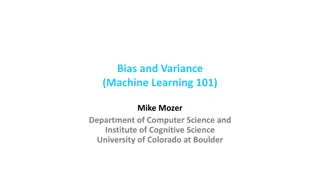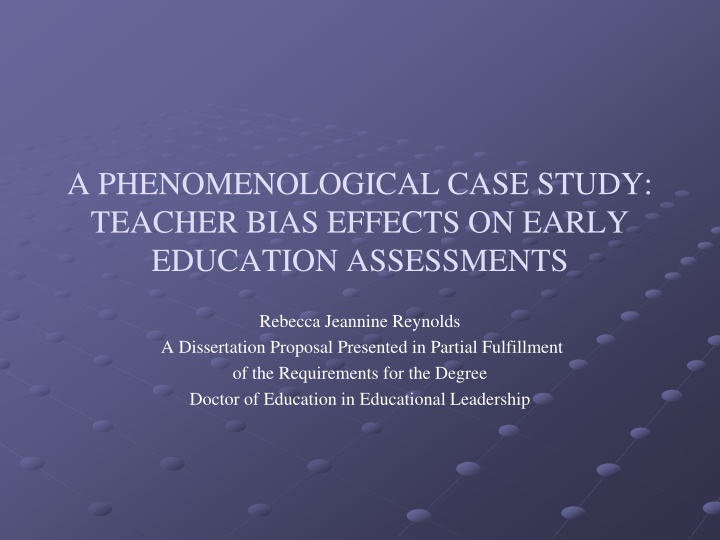
Teacher Bias Effects on Early Education Assessments
Explore the impact of teacher bias on early education assessments through a qualitative study analyzing perceptions of teachers. Understand how bias can influence children's educational trajectories and the importance of unbiased assessments in creating a fair learning environment.
Uploaded on | 0 Views
Download Presentation

Please find below an Image/Link to download the presentation.
The content on the website is provided AS IS for your information and personal use only. It may not be sold, licensed, or shared on other websites without obtaining consent from the author. If you encounter any issues during the download, it is possible that the publisher has removed the file from their server.
You are allowed to download the files provided on this website for personal or commercial use, subject to the condition that they are used lawfully. All files are the property of their respective owners.
The content on the website is provided AS IS for your information and personal use only. It may not be sold, licensed, or shared on other websites without obtaining consent from the author.
E N D
Presentation Transcript
A PHENOMENOLOGICAL CASE STUDY: TEACHER BIAS EFFECTS ON EARLY EDUCATION ASSESSMENTS Rebecca Jeannine Reynolds A Dissertation Proposal Presented in Partial Fulfillment of the Requirements for the Degree Doctor of Education in Educational Leadership
Introductions Joseph J. Saxton, Jr. Ed. D. Mentor Robert G. Smallfoot, Ph.D., Committee Member Kelley McLauchlan, Ph.D., Committee Member Rebecca Jeannine Reynolds, Doctoral Candidate 2
The Beginning Process Effective Teaching Assessment documentation With- out Bias Personal Interest in Bias
Outline Introductions The problem statement The purpose of the study Theoretical framework Research method and design Research question 1 Research Question 1 Answer Research Question 2 Research Question 2 Answer Bias: Definition and Theory Population and sample Data collection Research Results Significance of results to leadership Recommendations for Further Research Questions References 3
The Problem Statement Teacher bias written into documented observational assessments that follow children from one age group to the next is the general problem. Developmental assessments play an important role in the placement of children in different tracks in educational systems (Sch lmerich, 2008, p 188 ). The specific problem is that the inclusion of teacher bias in giving assessments to children enrolled in early education centers because if a teacher holds a negative expectation for a child, the child's school performance may not be accurately perceived (Foster, 1977, p. 533). In the problem of bias, the responsibility of leaders is to set an example of unbiased decisions, cultivating a new model of leadership. Cultivating a new model for leadership requires courage and emotional maturity as much as it does skill and effort (Lyons, 2007, p. 30); these leaders can be aware and curtail the impact of bias in the documentation of observational assessment. Understanding and eliminating bias will help alleviate stress that will affect children in the early education classroom while creating the new model. 4
The Purpose Statement The purpose of this qualitative, phenomenological study was to explore the perceptions of 20 teachers in their experience of bias in assessment documentation of preschool children. The study used 23 mixed participants: three pilot study participants and 20 final study participants in Chicago area preschools. Data was collected by using open ended questions and then analyzed and coded for emerging themes and patterns. The study attempted to bring a deeper understanding of the issues surrounding testing at the preschool level. The findings include a mixed response with themes and patterns found in identifying how bias affects documented observational assessment.
Theoretical Framework The framing theories of teacher bias consist of child development, observational assessment, and bias. The major models framing teacher bias influence of recorded documentation of children s assessment include child development theory, child development, observational assessment, and bias. Child Development Teacher Bias Observational Assessment Bias 6
Research Method and Design Validity Phenomenological Multiple sources of data o Case Study Triangulation Theory, literature and research surrounds data. o Purposeful Sampling o Interviews o Data Analysis/Coding Multiple participants Reliability 7
Research Question Number One How do teachers feel the bias of other teachers influence the recorded documentation of children s assessment when a teacher documents the observations of children in the classroom? Case by Case Provides Purpose Seeks to Create Knowledge Accessibility Addresses Issues Seeks Input 8
Research Question Number One: Answer Five out of 20 or 25% of teachers describe bias being documented into observational assessment.
Research Question Number Two How do teachers feel the assessment from a previous teacher affects the new teacher s teaching methods when a child s assessment follows the child into the next age group? Principal Comparison Extensiveness Addresses Issues Seeks Input Follows Through
Research Question Number Two: Answer 4 out of 20 or 20% of teachers describe bias as affecting the new teacher s teaching methods when a child s assessment follows the child into the next age group.
Bias Definition Bias: According to Swee- Choo (2008), bias is behaviors of unfair treatment, personal, and shows favoritism. Theory Self-perception Theory (SPT) individuals infer their attitudes, internal states, and dispositions by observing their own behavior and that of others, providing individuals with feedback about their behavior (Vogt, 2009, 175).
Population and Sample Early Education Teachers of Preschool Current or past employment as a classroom preschool teacher Experienced in observational assessment 20 teachers from Chicago area early education centers 9
Data Collection Method A voice recorder and the Naturally Speaking 10 Dragon program were used to write dictation of the recorded interviews. Consent forms were signed by each school and teachers who participated. Each interview took place at a location of each individual teachers choosing, and were recorded and transcribed for each interview response (Chamberlain, 2008, p71). Each interview transcription was imported into the Nvivo9 program for anaysis 13
Research Results 19 out of 20 have worked with bias in the classroom environment 17 out of 20 have had experience with working in a classroom that had no bias involved in the classroom An overlap of Bias Yes and Bias No was found. Fifteen of the participants interviewed identified both Bias Yes and Bias No as being present at various times of their teaching tenure giving an unclear pattern of bias.
Research Results continued 4 out of 20 or 20% of teachers describe bias as affecting the new teacher s teaching methods when a child s assessment follows the child into the next age group 5 out of 20 or 25% of teachers describe bias being documented into observational assessment 15
Significance of Results to Leadership Help leaders adjust and create ways of documenting assessments to ensure accuracy without teacher bias. Insight into the problem of teacher bias given to young children by teacher observation. Leaders can gather data to be used to develop a training device to reduce bias or to train teaching staff to reduce bias in the documentation of observational assessments. To train educators to ensure accuracy of documentation of children s educational records. 22
Suggested Observational Assessment Documentation Procedure Example OBSERVATION INTERPRETATION OPINION Kate cried when Josh took the flower out of her hand. Kate then babbled loudly pointing her finger at Josh. Josh stuck his tongue out at Kate. Kate then walked to the teacher and pulled on the teacher s shirt while babbling. Kate was unable to verbalize with vocabulary and showed her anger by pointing and babbling loudly. After Kate s flower was taken from her, she attempted to communicate with Josh. When communicating with Josh Kate didn t get the flower back, Kate then walked to the teacher to communicate the problem to her teacher.
Recommendations for Future Research 1. Expand the research to include other age groups and grade levels. How bias influences the recording of assessment and report card grades for grade school children, high school children and college students. 2. The last recommendation is to increase the study area to include other large cities to find further validity. 23
References Chamberlain, K. (2008). In Sanders R. (Ed.), Case study: Professional development that enhances teaching and learning. United States -- Arizona: University of Phoenix. Retrieved ProQuest, April 30, 2011. Foster, G., & Salvia, J. (1977, May). Teacher Response to Label of Learning Disabled as a Function of Demand Characteristics. Exceptional Children, 43(8), 533-534. Retrieved March 12, 2009, from Education Research Complete database Sch lmerich, A., Leyendecker, B., Citlak, B., Caspar, U., & J kel, J. (2008). Assessment of migrant and minority children. Zeitschrift f r Psychologie/Journal of Psychology, 216(3), 187-194. Retrieved March 12, 2009, doi:10.1027/0044- 3409.216.3.187 Swee-Choo, P. (2008). Teaching Practices that Hinder the Deep Approaches to Learning of Twinning Programme Students in Malaysia: A Qualitative Perspective. Asia-Pacific Education Researcher, 17(1), 63-73. Retrieved from Education Research Complete database. Vogt, F., Hall, S., Hankins, M., & Marteau, T. (2009). Evaluating three theory-based interventions to increase physicians' recommendations of smoking cessation services. Health Psychology, 28(2), 174-182. Retrieved from CINAHL Plus with Full Text database. 24
Questions What questions do you have? 25

